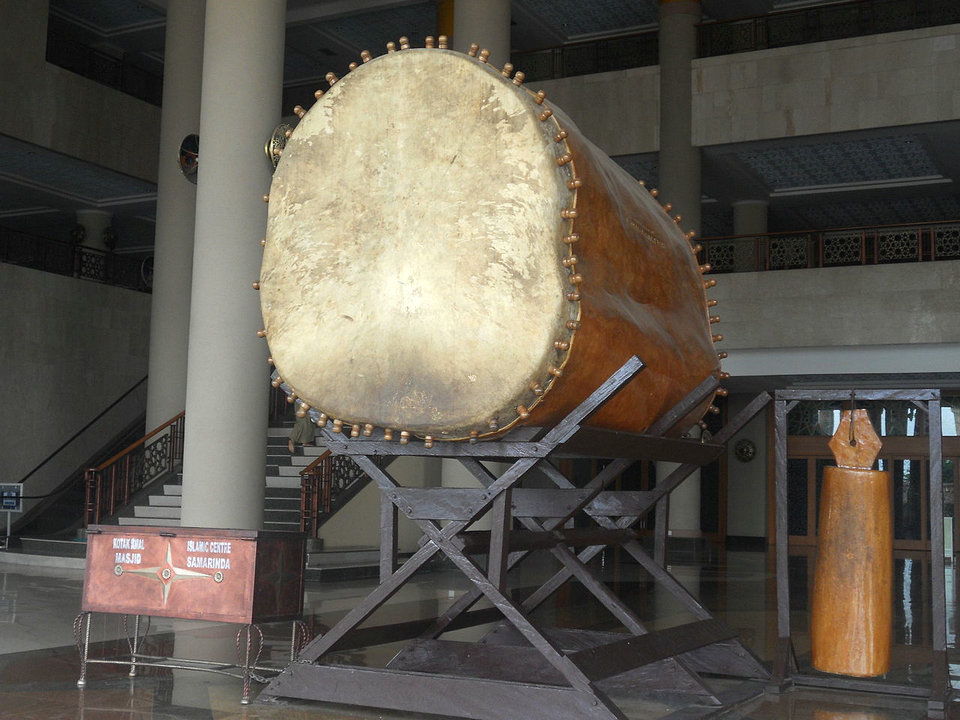

The beduk (Indonesian: bedug; Javanese: bedhug) is one of the drums used in the gamelan. It is used among Muslims in Java for religious purposes.
Overview
A bedug is a large double-barreled drum with water buffalo leather on both sides.
Unlike the more frequently used kendang, the bedug is suspended from a rack and played with a padded mallet and is not adjustable. The bedug is as large or larger than the largest kendang and generally has a deeper and duller sound. The drum has pegs holding the two identical heads in place similar to the Japanese taiko.
History
Bedug actually comes from India and China . Based on the legend of Cheng Ho of China, when Admiral Cheng Ho came to Semarang , they were welcomed by the King of Java at that time. Then, when Cheng Ho was about to leave, and was about to give a present, the king of Semarang said that he only wanted to hear the drum sound from the mosque . Since then, the drum has become part of the mosque, as in China , Korea and Japan , which positioned the drum in the temples as a means of religious ritual communication. In Indonesia, an ordinary drum is sounded for notices of prayer time or prayer. When the Orbian ruling drum has been removed from the mosque and mosque because it contains elements of non-Islamic. Bedug is replaced by loudspeakers. This was done by modernist Islamists, but NU citizens took up the resistance so that now there are still many mosques that defend the drum.
Usage
The bedug is not used in most gamelan performances. It is used in special ensembles like the gamelan sekaten, where it takes the place of the kempul. In some pieces it is played along with the kendang, especially to accompany dancing.
The bedug is commonly used in mosques in Java among Javanese and Sundanese people to preclude the adhan as a sign for prayer or during Islamic festivals. For example, the sound of a bedug is used to signal the end of the daylong fast during Ramadan and sometimes it is used to signal time for Suhoor during Ramadan. When used to signal time for Friday prayer, the bedug is beaten in a different way than for ordinary prayers. The bedug is also used to celebrate takbiran, the night before Eid ul-Fitr when people chant takbir and hit the bedug in Indonesian Lebaran tradition.
Function
Social function: bedug serves as a means of communication or a marker of community activities, ranging from worship, danger signs, to the mark of a community gathering.
Aesthetic function: The bedug works in the development of the creative world, concepts, and culture of musical material.
How to make simple
At first, goats or cows skinned. Ordinary animal skin made as raw materials such as goat skin, cow, buffalo , and bull . White cowhide has better quality compared to cow leather. Because, the cow’s skin is thicker than the skin of brown cow, so the resulting sound will be different in addition, lower durability. Then, the skin is soaked into detergent water about 5 – 10 minutes . Do not be too long to avoid damage. Then, the skin is dried in a way dipanteng (held) so as not to shrink. After dry, measured diameter of wood that has been painted and will be made drum. After completion is measured, the skin is attached to the prepared wooden cobblestone. The process of unifying animal skin with wood is done with nails and some rigging.
Game (art ngadulag)
Art ngadulag comes from the area of West Java . Basically, the drum has the same function as described earlier. However, the drum stroke in each region has differences with other areas, making it distinctive. So it was born a term “ngadulag” which refers to a drumming skill. Now the drumming skill has become an independent art form that is art Ngadulag (game drum). In Bojonglopang area, Sukabumi , ngadulag art has become a competition to get the best drummer. Competition is divided into 2 categories, namely beauty and resilience. The beauty gives priority to the rhythm and rhythm of the drum beat, while the durability of putting endurance on the beat or how long the power to beat the drum. This competition is followed by men and women. From this game the art of beating the drum developed. In the past, the art equipment drummed drum only consists of bedug, kohkol, and trumpet. But now the equipment is also developing. In addition to the above mentioned, drum beat is now also equipped with musical instruments such as guitars , keyboards , and cymbals .
Largest in the World
The largest drum in the world is inside the Darul Muttaqien Mosque, Purworejo . This Bedug is a great work of Muslims whose production is ordered by Adipati Tjokronagoro I, the first Purworejo Regent. made in 1762 Java or 1834 AD . And named Kyai Begelan. The size or specification of this bedug is: Length 292 cm, circumference of 601 cm front, rear circumference 564 cm, front diameter 194 cm, diameter rear 180 cm. The drummed part of this drum is made from the skin of a bull. This gigantic bug is designed as a “means of communication” to invite the congregation to be heard as far as possible through the drum beat as a sign of prayer time before the call to prayer.
Source From Wikipedia